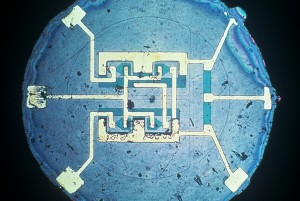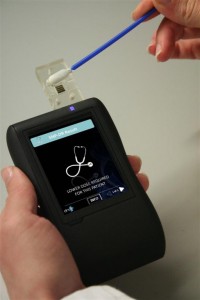SouthWest celebrates 50 years of the silicon microchip
The SouthWest figures heavily in the 50th anniversary of the microchip this week, says SiliconSouthWest.
The silicon integrated circuit (IC, left) as we know it was patented by Fairchild Semiconductor’s Robert Noyce who received the first patent for a commercially available silicon IC on the 25th of April 1961. Plessey Semiconductor in Swindon was developing a silicon chip at the same time following the first chip (in a different technology) shown by Texas Instruments a few years earlier in 1958. Fairchild set up in Swindon in 1972, with Intel close by in 1974.
The National Microelectronics Institute (NMI) highlights the current state of the art for microchip technology with SouthWest activity from the University of Southampton, Toumaz in Oxford, Imagination Technology in Chepstow, Dialog Semiconductor in Swindon and Plessey Semiconductors in Plymouth and Swindon.
The UK is home to over 40 per cent of Europe’s independent electronic design community and its 11,500 companies and 250,000 people form an ecosystem worth £23 billion per year to the British economy, with the largest cluster of silicon designers here in the SouthWest. “You only have to look inside your mobile phone to see the British contribution,” said Dr Derek Boyd, head of the NMI. “You will likely find an ARM processor, a CSR Bluetooth and GPS chip, a Dialog Semiconductor power management device and an Imagination Technologies graphics core.”
“The UK’s microelectronics sector continues to be at the forefront of this innovation,” said Dr Boyd. “UK based researchers, technologists and manufacturers are creating chips and systems capable of genetic disease detection, determining the build up of pollutants in the oceans, emitting light that sterilises drinking water or medical instruments, analysing the structural integrity of high-speed rail lines, and the early identification of injuries in racehorses.”
- A chip capable of detecting single nucleotide polymorphisms (SNPs) inDNA has been developed which gives results in minutes – DNA amplification, sequencing and analysis typically takes days. The device can be configured to detect any SNP, making it applicable to medicine, agriculture and pharmacology. The technology has been developed by Professor Chris Toumazou, founder and CEO of Toumaz Technologies and DNA Electronics.
- Researchers at Southampton University have created a chip to detect nutrients and pollutants at the ultra low concentrations found in the ocean. Developed in collaboration with the National Oceanography Centre, the ‘labon chip’ is capable of capable of measuring temperature, salinity, and the concentrations of nitrites, nitrates, phosphate, iron and manganese
- Plessey Semiconductor, in collaboration with Cambridge University, is developing an LED (light emitting diode) that uses Gallium Nitride to releaselight at wavelengths lethal to bacteria – 265nm. The low cost technology will be made available during this decade and be powered by solar cells. Plessey believes it will be adopted in developing economies or disaster zones to create clean drinking water, and in the developed world to replace chlorine sterilisation methods. Additional uses include the sterilisation of medical instruments.
- Accelerometer chips are being developed at the University of Southampton that, among other applications, are capable of detecting weaknesses in high-speed rail networks. The highly sensitive chips monitor how a section of track behaves whilst a train is on it. Any changes in behaviour can be used to determine changes in its structural integrity.
The NMI has also highlighted transport, digital media, communications, healthcare and smart energy grids as key growth areas for the electronics industry, all strong areas for the SouthWest.
Related articles
- Intel chips grow up; Company says 3-D transistors will allow for microprocessors that are smaller, faster and more efficient (bendbulletin.com)
- Intel to use vertical FINFET transistors in chips by year end – video and update (The Embedded Blog)
Comments
Tell me what you're thinking...
and oh, if you want a pic to show with your comment, go get a gravatar!



